Orange County Convention Center
-
- Adances in Marine Coatings & Corrosion Control Maritime Reporter, Mar 2013 #46
Keeping hulls and equipment ship shape, coatings play critical role in vessel efficiency, economy
The advance of modern marine coatings and related technologies is not unlike other technical sectors of the maritime industry, primarily driven by emerging regulation from the international, national and regional level, usually in regard to environmental concern.
But in recent years, an increased focus on the reduction of marine emissions in tandem with the capability to more directly correlate clean, well-maintained hulls with reduced fuel consumption and lower emissions has driven the industry further faster, as coatings manufacturers globally strive for new formulations designed to apply easier, wear longer and ultimately become an indispensible tool in the vessel owner’s arsenal to run cleaner, more efficient vessels.
The Coatings
Late last year Hempel launched Hemparea 55973, a fast-drying anticorrosive coating suitable for C3 corrosive environments with a cure time of just one hour. Its quick dry time, along with a single-coat combination of primer and topcoat, increases line-speeds for heavy machinery by at least 50% in comparison to standard two and three coat systems, the manufacturer claims, helping to complete the coating process in a timelier, more cost-efficient manner.
New to the market are International Paint’s two latest antifouling coatings, Intercept 8000 LPP and Intersleek 1100SR. Intercept 8000 LPP, is a biocidal linear polishing polymer antifouling featuring patented Lubyon technology that is designed to deliver predictable long term performance for in-service periods up to 90 months, International reports, and Intersleek 1100SR, is a biocide free fouling control coating featuring slime release technology that combats micro fouling on ships hulls, maintaining performance throughout the docking cycle
Lubyon polymer technology (found in Intercept 8000) aims to give the coating a ‘superhydrophilic’ surface. International explains, when the coating is immersed, the seawater has a lubricating effect, resulting in less friction, thus reducing drag and increasing vessel efficiency to give average fuel consumption and associated emissions savings of 5% annually compared to typical controlled depletion polymer antifoulings.
Intersleek 1100SR, reported to be the shipping industry’s first biocide free, fluoropolymer technology that tackles the ‘slime challenge.’ According to a recent formula produced by Michael P. Schultz, Professor, Department of Naval Architecture & Ocean Engineering, US Naval Academy, at today’s bunker prices, the effects of slime potentially costs the shipping industry 44 million extra tons of bunker fuel, $28.6 billion in additional fuel costs and an extra 134 million tons of CO2 emissions every year. Designed for all commercial vessels, even when slow or ultra slow steaming, Intersleek1100SR slime release technology is designed to deliver macro and micro fouling control with static resistance even in warm waters.
Sigma Ecofleet 690 is designed to provide high performance antifouling for short sea and coastal shipping, the newest addition to the Sigma Ecofleet range which provides predictable antifouling protection at variable operating speeds in aggressive fouling environments. Developed specifically for the dry dock, maintenance and repair market, Sigma Ecofleet 690 has been formulated using PPG’s unique patented binder technology ensuring consistent performance levels and fouling control for in-service periods of up to 60 months.
Fully compliant with the IMO AFS Convention, the product is suitable for a wide range of vessel types and contains an ultra-high volume solids content of 70% - thus reducing potential VOC emissions. Sigma Ecofleet 690 has been formulated to be easy to apply, increasing productivity and reducing overall maintenance costs.
Funded by the U.S. Office of Naval Research and the Materials Research Science and Engineering Center, Duke University engineers have produced a hull coating that dislodges bacteria with the application of an electrical current, thus avoiding the use of bacteria-killing paints which can contain heavy metals or other toxic chemicals that might harm fish or other sea life. The material works by physically moving at the microscopic level, knocking away bacteria. “We have developed a material that ‘wrinkles,’ or changes its surface in response to a stimulus, such as stretching or pressure or electricity,” said Duke engineer Xuanhe Zhao, assistant professor in Duke’s Pratt School of Engineering. “This deformation can effectively detach biofilms and other organisms that have accumulated on the surface.”
Micanti, a Holland-based maritime technology company, introduced an environmentally friendly antifouling option called Thorn-D. A nontoxic adhesive foil used in place of environmentally contaminating chemical coatings, Thorn-D has a textured surface that prevents marine growth from attaching to the hull. “The basic thought behind Thorn-D is that a combination of prickliness and swaying of Thorn-D fibers makes the surface unattractive for organisms,” said Micanti founder, Dr. Rick Breur, in a recent press release. “The technology provides a physical barrier in the shape of specific short fibers for organisms such as mussels, barnacles and algae to settle.”
Also declaring reduced application costs, Sherwin-Williams launched Macropoxy 80, a high-build HAPs-free epoxy formulated for application over marginally prepared steel substrates and damp surfaces, lessening the need for costly surface preparations. The coating combats corrosion from both immersion and atmospheric exposures and can be applied at temperatures as low as 0°F. Because of its surface tolerance, Macropoxy 80 can be applied in adverse conditions, and steel substrates need only to be cleaned of loose paint or rust per SSPC SP2-3 Hand and Power Tool Cleaning before application. Its high solids formulation (80%) reduces the likelihood of the solvent entrapment that can lead to premature coating failure. In addition to being HAPS-free, Macropoxy 80 is low-VOC (<250 g/L).
GuardLine LTC (Low Temperature Cure), a new cargo tank coating from Advanced Polymer Coatings, is an ambient-cure coating (in the range of 77°F) used on chemical, product and barge tankers to transport a range of liquid cargos. GuardLine LTC only requires a low temperature cure, generating cost savings by eliminating the extra step of a high temperature forced hot air heat cure, which is crucial for the high chemical resistance of the MarineLine 784 system used for chemical tankers and their more hazardous cargos.
APC also claims its LTC coating offers greater versatility and chemical resistance and requires less cleaning because it is virtually absorbent-free, giving ship operators the opportunity to carry a wider range of cargos without worrying about the previous cargo residue contaminating the next one.Advanced Polymer Coatings
www.ad-polymer.com
Hempel
www.hempel.com
International Paints
www.international-marine.com
Micanti
www.micanti.com
PPG Protective & Marine Coatings
www.ppg.com
Sherwin-Williams
www.sherwin-williams.comMarch 17-21, 2013
Orange County Convention Center, Orlando, FL
The 2013 NACE International Corrosion Conference offers technical and educational resources, public awareness activities and exhibition. More than 5,000 corrosion professionals are expected to participate, and the exhibition will feature more than 370 companies displaying the latest in corrosion control products and services. The technical program, with more than 30 symposia, will feature several new offerings, including corrosion mitigation of fire protection systems, corrosion issues related to water systems and the environment and the relationship between coatings and CP.
www.nace.org
(As published in the March 2013 edition of Maritime Reporter & Engineering News - www.marinelink.com)
-
 )
March 2024 - Marine Technology Reporter page: 26
)
March 2024 - Marine Technology Reporter page: 26FEATURE OCEANOGRAPHIC INSTRUMENTATION & SENSORS Kevin Mackay, TESMaP voyage leader and Center head of the South and West Paci? c Regional Centre of Seabed 2030. Kevin in the seismic lab at Greta Point looking at the Hunga Tonga-Hunga Ha’apai volcano 3D map completed with data from the TESMaP voyage
-
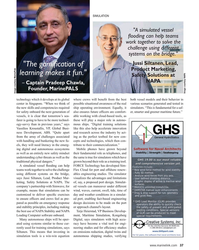 )
April 2024 - Maritime Reporter and Engineering News page: 37
)
April 2024 - Maritime Reporter and Engineering News page: 37SIMULATION "A simulated vessel ? ooding can help teams work together to solve the challenge using different systems on the bridge." – Jussi Siltanen, Lead, "The gami? cation of Product Marketing, learning makes it fun." Safety Solutions at NAPA – Captain Pradeep Chawla, Founder, MarinePALS Image
-
 )
April 2024 - Maritime Reporter and Engineering News page: 35
)
April 2024 - Maritime Reporter and Engineering News page: 35SIMULATION e have a close relationship with tech- Realism is prized beyond immersive, photo-realistic visu- nology, evidenced by, for example, als, and providers are introducing increasingly accurate func- the phones we are estimated to un- tionality. FORCE Technology’s upcoming DEN-Mark2 math- lock around
-
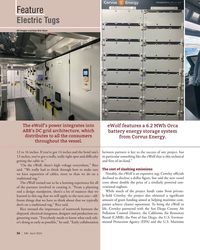 )
April 2024 - Marine News page: 34
)
April 2024 - Marine News page: 34Feature Electric Tugs All images courtesy Eric Haun The eWolf’s power integrates into eWolf features a 6.2 MWh Orca ABB’s DC grid architecture, which battery energy storage system distributes to all the consumers from Corvus Energy. throughout the vessel. 12 to 16 inches. If you’ve got 14 inches and
-
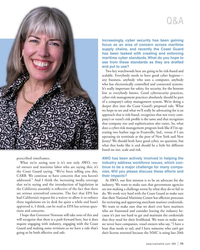 )
April 2024 - Marine News page: 11
)
April 2024 - Marine News page: 11Q&A Increasingly, cyber security has been gaining focus as an area of concern across maritime supply chains, and recently the Coast Guard has been tasked with creating and enforcing maritime cyber standards. What do you hope to see from these standards as they are drafted and put to use? Two key
-
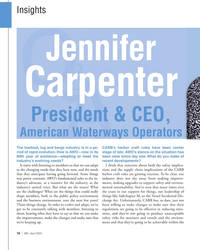 )
April 2024 - Marine News page: 10
)
April 2024 - Marine News page: 10Insights Jennifer QQQQQQQQQAAA & Carpenter President & CEO, American Waterways Operators The towboat, tug and barge industry is in a pe- CARB’s harbor craft rules have been center riod of rapid evolution. How is AWO—now in its stage of late. AWO’s stance on the situation has 80th year of existence—adapt
-
 )
February 2024 - Maritime Reporter and Engineering News page: 44
)
February 2024 - Maritime Reporter and Engineering News page: 44Tech Files Latest Products & Technologies MarineShaft Yanmar Hydrogen MarineShaft specializes in urgent re- Fuel Cell AIP pair/replacement of damaged rudder and Yanmar Power Technology Co., Ltd. propeller equipment along with many (Yanmar PT), a subsidiary of Yanmar on-site repair services. MarineShaft
-
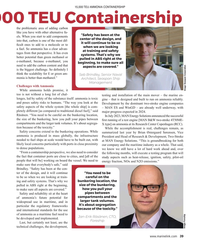 )
February 2024 - Maritime Reporter and Engineering News page: 39
)
February 2024 - Maritime Reporter and Engineering News page: 3915,000 TEU AMMONIA CONTAINERSHIP 000 TEU Containership the problematic area of adding carbon like you have with other alternative fu- “Safety has been at the els. When you start to add components center of the design, and into that, carbon is one of the most dif- it will continue to be so ? cult ones
-
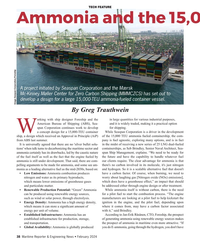 )
February 2024 - Maritime Reporter and Engineering News page: 38
)
February 2024 - Maritime Reporter and Engineering News page: 38TECH FEATURE Ammonia and the 15,00 A project initiated by Seaspan Corporation and the Mærsk Mc-Kinney Møller Center for Zero Carbon Shipping (MMMCZCS) has set out to develop a design for a large 15,000-TEU ammonia-fueled container vessel. Image Seaspan Corporation/Foreship By Greg Trauthwein orking with
-
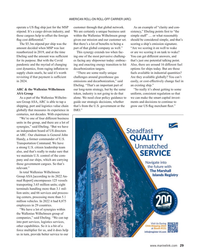 )
February 2024 - Maritime Reporter and Engineering News page: 29
)
February 2024 - Maritime Reporter and Engineering News page: 29AMERICAN ROLL-ON ROLL-OFF CARRIER (ARC) operate a US ? ag ship just for the MSP customer through that global network. As an example of “clarity and con- stipend. It’s a cargo driven industry, and We are certainly a unique business unit sistency,” Ebeling points ? rst to “the those cargoes help to
-
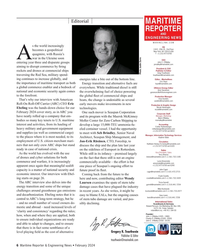 )
February 2024 - Maritime Reporter and Engineering News page: 6
)
February 2024 - Maritime Reporter and Engineering News page: 6Editorial MARITIME REPORTER AND ENGINEERING NEWS M A R I N E L I N K . C O M s the world increasingly HQ 118 E. 25th St., 2nd Floor becomes a geopolitical New York, NY 10010 USA T +1.212.477.6700 quagmire, with Russia’s Awar in the Ukraine soon CEO John C. O’Malley entering year three and disparate
-
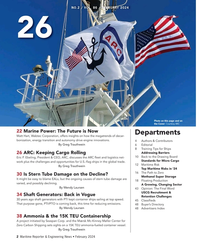 )
February 2024 - Maritime Reporter and Engineering News page: 2
)
February 2024 - Maritime Reporter and Engineering News page: 2NO.2 / VOL. 86 / FEBRUARY 2024 26 Photo on this page and on the Cover: Courtesy ARC 22 Marine Power: The Future is Now Departments Matt Hart, Wabtec Corporation, offers insights on how the megatrends of decar- bonization, energy transition and autonomy drive engine innovations. 4 Authors & Contributors By
-
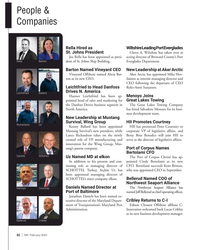 )
February 2024 - Marine News page: 42
)
February 2024 - Marine News page: 42People & Companies Rella Hired as Wiltshire Leading Port Everglades St. Johns President Glenn A. Wiltshire has taken over as Joe Rella has been appointed as presi- acting director of Broward County’s Port Rella Barton dent of St. Johns Ship Building. Everglades Department. Barton Named Vineyard CEO New
-
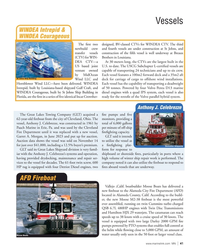 )
February 2024 - Marine News page: 41
)
February 2024 - Marine News page: 41Vessels WINDEA Intrepid & WINDEA Courageous The ? rst two designed, BV-classed CTVs for WINDEA CTV. The third newbuild crew and fourth vessels are under construction at St Johns, and transfer vessels construction of the ? fth vessel is well underway at Breaux (CTV) for WIN- Brothers in Louisiana.
-
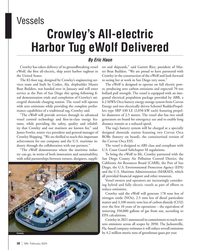 )
February 2024 - Marine News page: 38
)
February 2024 - Marine News page: 38Vessels Crowley’s All-electric Harbor Tug eWolf Delivered By Eric Haun Crowley has taken delivery of its groundbreaking vessel ers and shipyards,” said Garrett Rice, president of Mas- eWolf, the ? rst all-electric, ship assist harbor tugboat in ter Boat Builders. “We are proud to have partnered with the
-
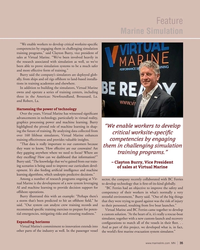 )
February 2024 - Marine News page: 35
)
February 2024 - Marine News page: 35Feature Marine Simulation “We enable workers to develop critical worksite-speci? c competencies by engaging them in challenging simulation training programs,” said Clayton Burry, vice president of sales at Virtual Marine. “We’ve been involved heavily in the research associated with simulation as well
-
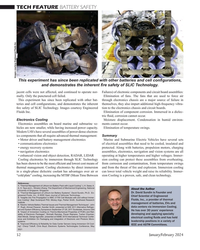 )
January 2024 - Marine Technology Reporter page: 52
)
January 2024 - Marine Technology Reporter page: 52TECH FEATURE BATTERY SAFETY Images courtesy Engineered Fluids Inc. This experiment has since been replicated with other batteries and cell con? gurations, and demonstrates the inherent ? re safety of SLIC Technology. jacent cells were not affected, and continued to operate nor- Failures) of electronic
-
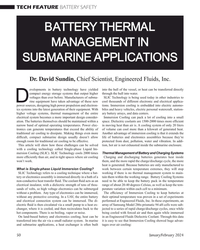 )
January 2024 - Marine Technology Reporter page: 50
)
January 2024 - Marine Technology Reporter page: 50TECH FEATURE BATTERY SAFETY BATTERY THERMAL MANAGEMENT IN SUBMARINE APPLICATIONS Dr. David Sundin, Chief Scientist, Engineered Fluids, Inc. evelopments in battery technology have yielded into the hull of the vessel, or heat can be transferred directly compact energy storage systems that output higher
-
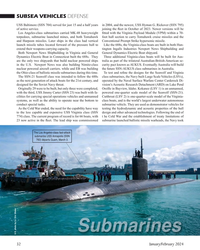 )
January 2024 - Marine Technology Reporter page: 32
)
January 2024 - Marine Technology Reporter page: 32SUBSEA VEHICLES DEFENSE USS Baltimore (SSN 704) served for just 15 and a half years in 2004, and the newest, USS Hyman G. Rickover (SSN 795) of active service. joining the ? eet in October of 2023. Newer versions will be Los Angeles-class submarines carried MK-48 heavyweight ? tted with the Virginia
-
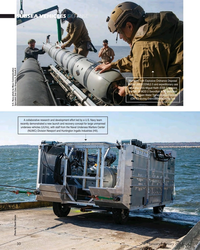 )
January 2024 - Marine Technology Reporter page: 30
)
January 2024 - Marine Technology Reporter page: 30SUBSEA VEHICLES DEFENSE Members from Explosive Ordnance Disposal Mobile Unit (EODMU) 5 and expeditionary sea base ship USS Miguel Keith (ESB 5) prepare the MK 18 MOD 2 Sword? sh to be deployed from the Open Water Transportation System (OWTS) during Exercise Noble Vanguard. U.S. Navy photo by Mass
-
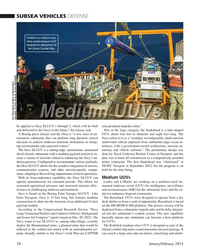 )
January 2024 - Marine Technology Reporter page: 28
)
January 2024 - Marine Technology Reporter page: 28SUBSEA VEHICLES DEFENSE Knife? sh is a medium-class mine countermeasure UUV designed for deployment off the Littoral Combat Ship. U.S. Navy photo by Mass Communication Specialist 1st Class Brian M. Brooks/RELEASED be applied to Orca XLUUV 1 through 5, which will be built (encapsulated torpedo) mine.
-
 )
January 2024 - Marine Technology Reporter page: 27
)
January 2024 - Marine Technology Reporter page: 27Snakehead is a modular, recon? gurable, multi-mission underwater vehicle deployed from submarine large ocean interfaces, with a government-owned architecture, mission autonomy and vehicle software. Photo by Richard Allen, Naval Undersea Warfare Center Division Newport www.marinetechnologynews.com
-
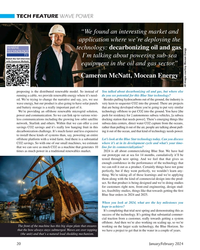 )
January 2024 - Marine Technology Reporter page: 20
)
January 2024 - Marine Technology Reporter page: 20TECH FEATURE WAVE POWER “We found an interesting market and application where we’re deploying the MARINE technology: decarbonizing oil and gas. TECHNOLOGY TV I’m talking about powering sub-sea Watch the full interview with Cameron McNatt: equipment in the oil and gas sector.” Cameron McNatt, Mocean
-
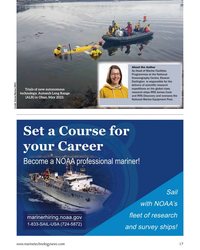 )
January 2024 - Marine Technology Reporter page: 17
)
January 2024 - Marine Technology Reporter page: 17About the Author As Head of Marine Facilities Programmes at the National Oceanography Centre, Eleanor Darlington is responsible for the delivery of scienti? c research expeditions on the global class Trials of new autonomous research ships RRS James Cook technology, Autosub Long Range and RRS
